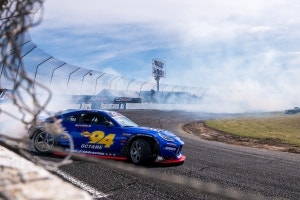
A Cooler for Atlas - Transmission Cooler R&D, Part 4: Testing
After all the time spent designing, welding, prototyping, and fitting, we were more than anxious to test the cooler and see if all our work would pay off.
Testing wouldn't be easy though. The weather outside was growing colder every day, and cold is the enemy when you're trying to push the limits of a heat exchanger. Nevertheless, on-road testing would yield the most relevant results for our customers, so we had to try. We hitched a trailer to our 5.9L Cummins volunteer truck, loaded our 6.7L Powerstroke, and hit the road. Temperature sensors in the inlet and outlet of the transmission cooler would let us know when we had maxed out the cooling potential of the stock cooler. Once the inlet and outlet temperatures leveled out, we could record the final temperature and swap in our cooler to repeat the test. But the temps never leveled out.

Each trip back down the hills of eastern Maryland cooled the transmission fluid enough that the trip up the hill couldn't bring the temp high enough to reach the stock cooler's maximum efficiency. Without a much heavier load or a long drive out to the Appalachians, our road testing wasn't going to work.
Sometimes the adage of "hope for the best, plan for the worst" pays off. While we had hoped our road testing would work out, we decided to hedge our bets and have a backup plan. Accompanying all our AEM data logging equipment was an OBD logger set to record the calculated load on the engine and transmission. Our plan, if the road testing didn't yield acceptable results, was to use that load figure to set our DynaPack dynos.

The DynaPacks use hydraulic pressure to load the hubs of the truck and keep them at a specific speed. If we could set the DynaPacks to a speed that would replicate the load we saw while towing, we could mimic towing our 6.7L up an endless grade until the stock cooler was no longer efficient. The risk in using this method would be overheating the DynaPacks.
If you've read our 2nd Gen transmission cooler blog, you probably know where this is going.
We decided to start with our massive transmission cooler, since it was more likely to overheat the DynaPacks. If the Dynapacks overheated before the cooler inlet and outlet temps leveled out, we would have to find a new method for testing the cooler's efficiency. With our cooler installed, the project engineer bolted our 3rd Gen volunteer vehicle to the DynaPacks and started the load testing. A short while later the smell of hot hydraulic fluid and the scream of the DynaPacks' temp alarm filled our engineering facility. Not all was lost, however. Even though our DynaPacks overheated, failing to push our cooler to the limits, we were able to verify that our thermostat was functioning correctly with our FLIR camera.

It was around this same time that we had similar issues testing our 2nd Gen transmission cooler. From those failures came our transmission cooler bench test. You can check out more details on our bench test rig in our 2nd Gen trans cooler post; but basically, this combination of high-end cooking equipment and automotive engineering let us replicate the transmission cooler circuit of the truck while controlling all of our testing variables. With this rig, we could finally find the limits of both coolers.

Once the ATF circulating through the cooler reached just over 200°F, we fired up our dyno fan and waited for that elusive leveling of the inlet and outlet temps. Finally, the temperatures leveled off. We had the data we needed to compare our 200%+ larger cooler to the stock cooler.

The results of the bench testing showed that our cooler is significantly more efficient than the stock counterpart. We saw a temperature reduction of 10°F at the cooler inlet and about 13°F at the outlet. Across the core, we saw a total reduction of nearly 40°F.

Our bench testing revealed favorable results, but we don't want you to just take our word for it. After the first hint of trouble during road testing, we wanted to get our cooler in the hands of somebody who really knows these trucks and drives them every day. Enter Muldoon's Diesel Performance. We sent one of our production samples off to John and Mike at Muldoon's to install on a 3rd Gen and give us their feedback. Check out what they had to say:
With testing complete and confidence that our cooler will live up to your expectations, we can officially put this cooler on pre-sale. Be sure to check out our website for more details on the pre-sale, and if you're just joining in, take a look at our previous posts to see how we got here. We want to extend a big thank you to John and Mike and Muldoon's Diesel Performance, and all of you, for helping us make this the best possible 2003-2009 Dodge Ram 5.9L/6.7L Cummins transmission cooler.
As always, feel free to let us know what you think!
Thanks for reading,
-Steve




